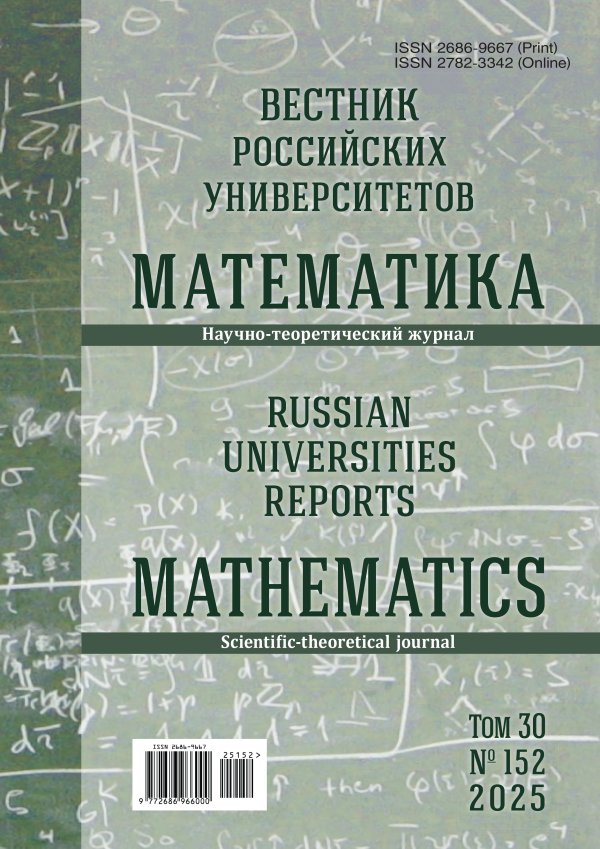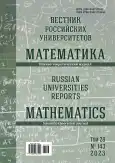Оценки фазовых траекторий управляемых систем с многозначными импульсными воздействиями
- Авторы: Филиппова О.В.1,2
-
Учреждения:
- ФГБОУ ВО «Тамбовский государственный университет им. Г.Р. Державина»
- ФГБУН «Институт проблем управления им. В. А. Трапезникова РАН»
- Выпуск: Том 28, № 143 (2023)
- Страницы: 326-334
- Раздел: Научные статьи
- URL: https://bakhtiniada.ru/2686-9667/article/view/296468
- DOI: https://doi.org/10.20310/2686-9667-2023-28-143-326-334
- ID: 296468
Цитировать
Полный текст
Аннотация
ассматривается управляемая система для дифференциального
уравнения где параметр $\xi$ является элементом некоторого заданного метрического пространства, управление $u$ удовлетворяет ограничению Предполагается, что в каждый из заданных моментов времени $t_k\in (a,b)$ решение $x:[a,b]\to \mathbb{R}^n$ (фазовая траектория) терпит разрыв, величина которого принадлежит непустому компакту $I_k(x(t_k))\subset \mathbb{R}^n,$ а на промежутках $(t_{k-1},t_k]$ является абсолютно непрерывной функцией. Функция управления предполагается измеримой. Доказана теорема об оценке расстояния от заданной кусочно абсолютно непрерывной функции $y:[a,b]\to \mathbb{R}^n$ до множества фазовых траекторий при всех начальных значениях из окрестности вектора $x_0$ и всех параметрах из окрестности точки $\xi_0.$ Предполагается, что при заданных начальном значении $\mathrm{x}=x_0$ решения и значении $\xi=\xi_0$ параметра множество фазовых траекторий априорно ограничено. Доказанная теорема позволяет путем подбора функции $y$ получить приближенное решение управляемой системы, а также оценку погрешности такого приближенного решения.
Об авторах
Ольга Викторовна Филиппова
ФГБОУ ВО «Тамбовский государственный университет им. Г.Р. Державина»; ФГБУН «Институт проблем управления им. В. А. Трапезникова РАН»
Автор, ответственный за переписку.
Email: philippova.olga@rambler.ru
ORCID iD: 0000-0003-1612-9880
кандидат физико-математических наук, доцент кафедры функционального анализа
Россия, 392000, Российская Федерация, г. Тамбов, ул. Интернациональная, 33; 117997, Российская Федерация, г. Москва, ул. Профсоюзная, 65Список литературы
- А.Ф. Филиппов, “О некоторых вопросах теории оптимального регулирования”, Вестник Московского университета. Серия: Математика, механика., 1959, №2, 25–32.
- T. Wazewski, “Systemes de commande et equations au contingent”, Bull. Acad. Polon. Sci., Ser.Math. Astr., Phys., 9:3 (1961), 151–155.
- T. Wazewski, “Sur une generalisation de la notion des solution d’une equations au contingent”, Bull. Acad. Polon. Sci., Ser. Math., Astr., Phys., 10:1 (1962), 11–15.
- С.В. Емельянов, А.В. Ильин, С.К. Коровин, В.В. Фомичев, А.С. Фурсов, Математические методы теории управления. Проблемы устойчивости, управляемости и наблюдаемости, 1-е изд., Физматлит, М., 2014.
- О.В. Филиппова, “Управляемые дифференциальные уравнения с параметром и с многозначными импульсными воздействиями”, Вестник российских университетов. Математика, 25:132 (2020), 441–447.
- П.И. Чугунов, “Свойства решений дифференциальных включений и управляемые системы”, Прикл. математика и пакеты прикл. программ. Иркутск: Изд-во СЭИСО АН СССР, 1980, 155-179.
- В.И. Благодатских, А.Ф. Филиппов, “Дифференциальные включения и оптимальное управление”, Топология, обыкновенные дифференциальные уравнения, динамические системы, Сборник обзорных статей. 2. К 50-летию института, Тр. МИАН СССР, 169, 1985, 194–252.
- Ю.Г. Борисович, Б.Д. Гельман, А.Д. Мышкис, В. В. Обуховский, Введение в теорию многозначных отображений и дифференциальных включений, 2-е изд., Книжный дом «ЛИБРОКОМ», М., 2016.
- А.И. Булгаков, О.В. Филиппова, “Импульсные функционально-дифференциальные включения с отображением, не обладающим свойством выпуклости по переключению значений”, Изв. ИМИ УдГУ, 2014, №1(43), 3–48.
- А.Н. Колмогоров, С.В. Фомин, Элементы теории функций и функционального анализа, 5-е изд., Наука, М., 2007.
- А.В. Арутюнов, Лекции по выпуклому и многозначному анализу, 1-е изд., ФИЗМАТЛИТ,М., 2014.
- А.И. Булгаков, Е.В. Корчагина, О.В. Филиппова, “Функционально-дифференциальные включения с импульсными воздействиями. Части I–VI”, Вестник Тамбовского университета. Серия: естественные и технические науки, 14:6 (2009), 1275–1313.
Дополнительные файлы









